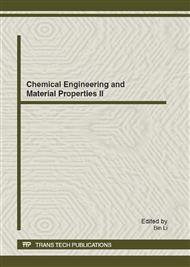[1]
G. Y. Shen, N. Sata, M. L. Rivers and S. R. Sutton: Appl. Phys. Lett Vol. 78 (2001), p.3208.
Google Scholar
[2]
R. H. French, J. Am. Ceram: Soc Vol. 73 (1990), p.477.
Google Scholar
[3]
B. Holm, R. Ahuja, Y. Yourdshahyan, B. Johansson, and B. I. Lundqvist: Phys. Rep Vol. 59 (1999), p.12777.
Google Scholar
[4]
F. H. Streitz , J. W. Mintmire: Phys. Rev. B Vol. 60 (1999), p.773.
Google Scholar
[5]
A. P. M. Catti, Acta Crystallogr and Sect. B: Struct. Sci Vol. 54 (1998), p.741.
Google Scholar
[6]
L. Q. Lobo, A. G. M. Ferrera: J. Chem. Thermodyn Vol. 33 (2001), p.1597.
Google Scholar
[7]
Q. Jiang, L. H. Liang and D. S. Zhao: J. Phys. Chem. B Vol. 105 (2001), p.6275.
Google Scholar
[8]
A. R. Regel', V. M. Glazov: Semiconductor Vol. 29 (1995), p.405.
Google Scholar
[9]
J. D. Hoffman: J. Chem. Phys Vol. 29 (1958), p.1192.
Google Scholar
[10]
Z. W. Wang, H. H. Mao and S. K. Saxena: J. Alloy. Compd Vol. 299 (2000), p.287.
Google Scholar
[11]
Z. W. Wang, P. Lazor and S. K. Saxena: Mater. Lett Vol. 49 (2001), p.287.
Google Scholar
[12]
A. Zerr, R. Boehler: Nature (London) Vol. 371 (1994), p.506.
Google Scholar
[13]
C. C. Yang, J. C. Li and Q. Jiang: Chem. Phys. Lett Vol. 372 (2003), p.156.
Google Scholar
[14]
Q. Jiang, H. X. Shi and M. Zhao: J. Chem. Phys Vol. 111 (1999), p.2176.
Google Scholar
[15]
S. Ansell, S. Krishnan and J. K. R. Weber: Phy. Rev. Lett Vol. 78 (1997), p.464.
Google Scholar
[16]
R. C. Weast, CRC Handbook of Chemistry and Physics, 69th ed., CRC Press, Inc., Boca Raton, Florida, 1988-1989, pp. D-46; pp. D-47; pp. F-13; pp. B-68; pp. B-98.
DOI: 10.1002/jctb.280500215
Google Scholar
[17]
A. R. Regel', V. M. Glazov: Semiconductor Vol. 29 (1995), p.405.
Google Scholar
[18]
N. A. Dubrovinskaya, L. S. Dubrovinsky, S. K. Saxena and Geo. Et Cosm: Acta Vol. 61 (1997).
Google Scholar
[10]
The necessary parameters in Eq. (6) are as follows: Tm = 2327 K.
Google Scholar
[15]
Hm = 21. 76 KJ g-atom-1.
Google Scholar
[16]
Sm=Hm/Tm= 9. 35 Jg-atom-1K-1, Sm=Sel+Spos+Svib, Sel is negligibly small, and Spos=-R[xAln(xA)+ xVln(xV)], where xA= 1/(1+ΔVm) and xV=ΔVm /(1+ΔVm) are the molar fractions of the host material and vacancies, respectively.
Google Scholar
[17]
and ΔVm is the volume difference between the crystal and corresponding fluid at Tm. As result, Svib= Sm-Spos or Svib » Sm+ R[xAln(xA)+ xVln(xV)].
Google Scholar
[23]
ΔVm=(VL-VS)/VS, Svib=5. 6 Jg-atom-1K-1, h = 0. 191 nm.
Google Scholar
[15]
g = 0. 690 Jm-2 , kS =3. 86×10-12 Pa-1 is determined by k =1/B with B =289. 55 GPa being the bulk modulus.
Google Scholar
[18]
VS = 5. 14 cm3 g-atom.
Google Scholar
[18]
VL = 6. 16 cm3g-atom-1.
Google Scholar
[15]
kL =57. 9×10-12 Pa-1 as a first-order approximation under higher pressure, we assume kL » 15kS.
Google Scholar
[13]
f is calculated through Eq. (2) and f = 4. 5 Jm-2. Fig. 1.
Google Scholar


